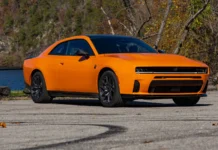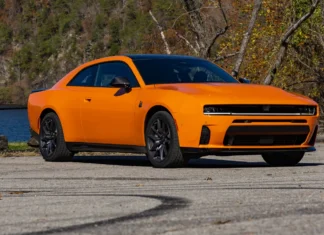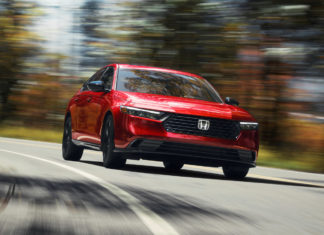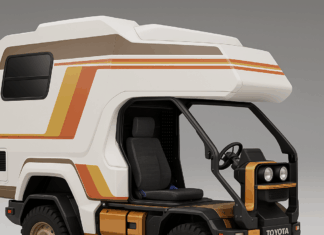
What is a good road trip car? It’s the one with a smooth ride, lots of space, and good economy. The 2012 Toyota Camry Hybrid XLE fits the bill just right. The question I wanted to answer on this trip was: how efficient is a Hybrid on a long and high speed road trip? After all, a Hybrid feels more at home in the city with slow stop-and-go traffic.
The Camry was redesigned inside and out for the 2012 model year. The exterior received front and rear fascia updates, and the interior was tweaked. The Camry was and still is the best selling mid-size sedan in America, so it did not need many drastic changes – just an update to keep it fresh and competitive. Personally, I am not a huge fan of the new exterior styling, but I have no complaints about the interior design and features.
The exterior color of this high-end XLE model is called “Cosmic Grey Mica” and contains the sparkling pearl-luster pigment. This paint effect received more than a few positive comments from the ladies. The good aerodynamics characteristics and overall quality of the redesigned Camry are evident when cruising at 75 mph down the interstate. There was virtually no tire or drive-train noise at speed. The wind noise was just noticeable, granted it was very windy for most of our trip.
The back seat of the Camry has plenty of leg room for two kids in child seats. It’s also wide enough for an average sized adult to seat in the middle, between the two kids. The LATCH system anchors were easy to reach and the seats installed quickly. Our car had the $1,160 optional leather-trimmed seats with Ultrasuede inserts. The suede inserts are a nice touch and help hold the occupants firmly in place. Although, it left my wife and I wondering about the long-term durability and stain resistance of this material. The seats are comfortable enough to make the 8 hour drive generally pleasant.
The Hybrid system battery pack does take away some trunk space that’s there in a regular Camry (2.3 cu-ft, to be exact). Nonetheless, I was able to load: a folding stroller, two folding kids chairs, three duffel bags full of cloths, two little hand-held coolers with drinks and snacks, a diaper bag, and some other odds and ends with a little room to spare! Also, it’s worth noting that the Hybrid has a much smaller rear seat pass-through for long items. The battery pack is located behind and under the rear seat, so only the passenger side rear seat-back folds down to provide an opening big enough for maybe two pairs of skies.
It’s somewhat of a mystery why the luxurious XLE Hybrid is rated at 40/38 mpg, which is significantly lower than the 43/39 mpg rating of a more basic LE Hybrid. Both use identical Hybrid Synergy Drive system that combine a 2.5 liter 4-cylinder gasoline engine with an electric motor (200 hp all together) and an electronically controlled CVT transmission. I can only work out that the additional 100 lbs or so of the XLE model must have something to do with this.
No matter. Our XLE did better than I expected on our trek between Denver, Colorado and Albuquerque, New Mexico. My wife, two kids, and I planned this trip to the Land of Enchantment to visit relatives and spectate the amazing Balloon Fiesta. Door to door, the one-way trip stretched just under 460 miles with 99% of it via Interstate I-25. We started with a full tank of fuel for both out and return trips. When we arrived in Albuquerque, Camry’s trip computer declared a trip average of 37.1 mpg with 93 miles of cruising range in reserve. However, as we rolled back into Denver, the trip computer surprised with an average of 40.2 mpg. Why this difference, when both trips followed the identical route and at nearly identical average speeds? As I mentioned, we encountered very strong head and cross winds on the way to New Mexico. The car reacted to wind conditions just like an airplane would. Fighting the wind for several hours took a toll on the fuel consumption. Averaging both legs of the trip, the car returned an overall 38.65 mpg. Looks like the EPA nailed the highway mpg rating.
The optional $500 Blind Spot monitoring system was useful on a long trip. However, there was one feature that I desperately missed. My fully loaded Camry Hybrid did not have Adaptive Cruise Control. Radar controlled cruise control is available on other Toyota’s, such as the Prius V, and it would have saved me a lot fiddling over the 920 miles that we traveled.
The 2012 Toyota Camry Hybrid XLE starts at $27,400. Our fully loaded model came out to $34,547. This included the backup camera, Safety Connect system, premium HDD Navigation with Entune, and power moonroof among other features.
The Camry Hybrid is facing stronger competition than ever: Hyundai Sonata, Kia Optima, and Ford Fusion – just to name a few. The 2013 Ford Fusion Hybrid is bringing the fight with a combined EPA rating of 47 mpg. I cannot wait to drive this one! There is one other car that may be better than the Camry Hybrid for a long trip haul. It’s the 2013 Volkswagen Passat TDI 6-speed manual. The diesel Passat was bred for high speed Autobahn travel and can do this with supreme efficiency. It can routinely post highway mpg numbers significantly higher than its 43 mpg EPA rating.
Watch this fun TFLcar video where this Camry gets mashed up against the Chevrolet Volt
In the end, this Camry surprised me with how well it handled the long haul, even with the 2.5 gasoline engine working overtime to charge the battery pack and propel the car down the interstate.
On the TFLcar scale of:
- Buy it!
- Lease it!
- Rent it!
- … or Forget it!
I give it a Buy It! There is a reason why this is the best selling sedan in the country. The Camry Hybrid is a high quality, comfortable, and capable car. If you like the style, go for it!

Andre Smirnov is a life-long automotive enthusiast, writer, and software engineer. On the weekends – you may find him at a car show, an auction, watching a race, or tinkering with a car in the garage. When not working or spending time with the family – he often scours the internet and other media for various automotive, mechanical, and computer related information.

































